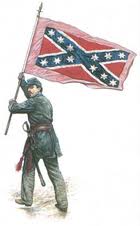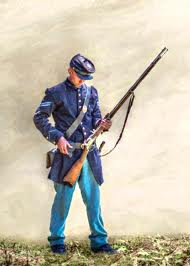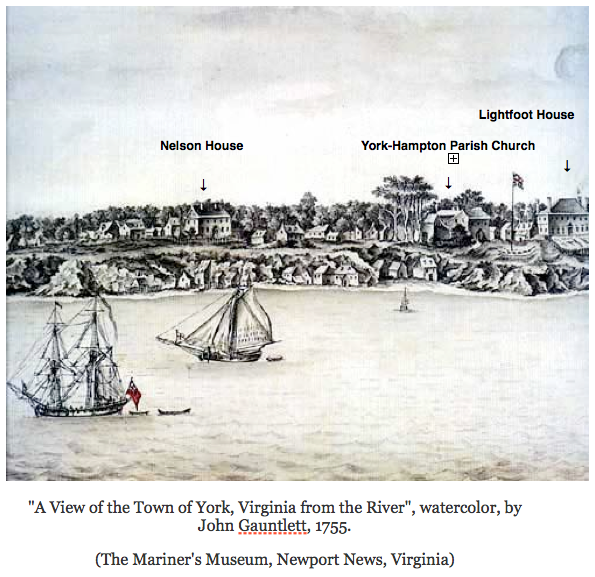EXCAVATION AT CHISKIACK
“Yorktown’s Buried History – From Chiskiack to the Civil War”, a booklet detailing the results of the dig became a project of the Yorktown Branch of the APVA. Along with Yorktown Historical Museum, the APVA raised the necessary funds for the book via special events, grants and donations.
The ground between Ballard and Buckner streets arguably is one of the most historic pieces of property in the county. In 1988, when plans were submitted to York County to build townhouses on that property, its archeological riches came precariously close to being lost forever. Fortunately, the developers were concerned that important archeological remains might be present on their proposed Chiskiack Watch development. On their own, they funded an excavation conducted by the Yorktown Archaeological Trust. Compressed on two colonial lots, they found evidence of 400 years of York County history, including Native American hearths, part of a 17th century fortification, the remains of an 18th century kitchen yard complex, and soldiers’ huts from the Revolutionary and Civil Wars.
Layers of History at the Chiskiack Site
The Land of the Chiskiacks
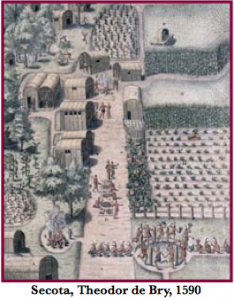 Long before Yorktown appeared on the map, the southern shore of the York River was the home territory of the Chiskiack Indians. The principal village of this Algponquian group, numbering around 200 men, women and children, was located about four miles upriver from the modern town site. By the Late Woodland period, beginning around 900 AD, the Chiskiacks had settled in loosely clustered, permanent villages.
Long before Yorktown appeared on the map, the southern shore of the York River was the home territory of the Chiskiack Indians. The principal village of this Algponquian group, numbering around 200 men, women and children, was located about four miles upriver from the modern town site. By the Late Woodland period, beginning around 900 AD, the Chiskiacks had settled in loosely clustered, permanent villages.
With their strategic location on the York River, the Chiskiacks were one of the first Native American groups to encounter European explorers. Around 1570, a small Spanish missionary party settled in the Chiskiack area. At first they were able to barter with the Native Americans for food, but in February 1571, the Chiskiacks attacked the mission killing the missionaries.
When John Smith and his fellow English explorers arrived at the mouth of the James River in 1607, they stumbled into the heart of the territory of the powerful Powhatan chiefdom. Ottahotin, the king of the Chiskiacks, was John Smith’s guide during a 1608 expedition to meet Powhatan at the Werowocomoco village in Gloucester County. The Chiskiacks were eventually forced out of their homeland by the pressure of English expansion.
In March 1622, a Native American uprising killed more than 300 of the 1200 colonists, creating the need for fortified settlements. The 1622 attack was followed by a decade of open warfare with intermittent raids, kidnappings and ambushes by both sides. A treaty in 1632 created a decade of tenuous peace. However, it barred all Indians from traveling on the lower James-York peninsula.
Nicholas Martiau’s home and fort – 17th Century
In 1620, Captain Nicholas Martiau, was sent by King James I to build forts in Virginia, specifically at York, and to complete the great log palisade between College and Queen Creeks for protection from Indian attacks. Nicholas Martiau, a military engineer and tobacco planter of French Huguenot descent, arrived in Virginia on the Frances Bona Venura . Martiau took up a large land grant at Chiskiack in 1630, formally patenting 1300 acres in 1640 where he resided until his death in 1657.
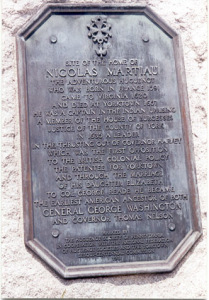 |
|
| Sign in Front of antique store, Ballard Street, Yorktown |
Site of the Home of Nicolas Martiau.
The Adventurous Huguenot Who was born in France 1591
Came to Virginia 1620
And Died at Yorktown 1657
He was a Captain in the Indian Uprising
A Member of the House of Burgesses
Justice of the County of York
In 1635 a Leader In the Thrusting out of Governor Harvey Which was the First Opposition To the British Colonial Policy
The Patentee for Yorktown
And Through the Marriage of his Daughter Elizabeth To Col. George Reade he became The Earliest American Ancestor of both General George Washington and Governor Thomas Nelson
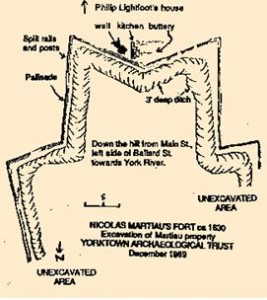 Evidence of a palisade trench and ditch were discovered during the archeological excavation.
Evidence of a palisade trench and ditch were discovered during the archeological excavation.
Lightfoot Home – 18th Century
Philip Lightfoot (1689-1748) moved to Yorktown about 1707 and built his home on the former Martiau site. The Lightfoot mansion was a status symbol of the branch of the Lightfoot family in Virginia who lived in Yorktown throughout most of the eighteenth century.
Revolutionary and Civil War
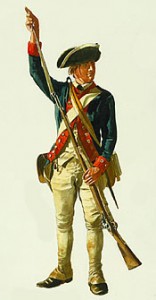 Evidence of both Revolutionary and Civil War soldiers’ huts were uncovered at the same site.
Evidence of both Revolutionary and Civil War soldiers’ huts were uncovered at the same site.